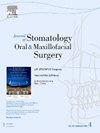一种新型非编码 m6A 阅读器 RBFOX2 在口腔鳞状细胞癌中表达增加并促进肿瘤发生。
IF 2
3区 医学
Q2 DENTISTRY, ORAL SURGERY & MEDICINE
Journal of Stomatology Oral and Maxillofacial Surgery
Pub Date : 2025-02-01
DOI:10.1016/j.jormas.2024.102041
引用次数: 0
摘要
背景和目的:口腔鳞状细胞癌(OSCC)因其侵袭性强、预后差而成为全球关注的重大健康问题。最近的研究强调了 RNA 修饰在癌症生物学中的重要作用,尤其是 N6-甲基腺苷(m6A)修饰,这种修饰受 m6A 调节因子复杂的相互作用控制。本研究特别研究了一种新的非编码 m6A 阅读器 RBFOX2 及其在 OSCC 中的参与情况:我们的研究主要利用 OSCC 组织、邻近的正常组织样本、OSCC 细胞系和正常健康的口腔角质细胞来验证 RBFOX2 mRNA 的表达。此外,我们还利用 TCGA-HNSC 数据集进行了大规模队列分析和临床病理特征描述。此外,我们还将 RBFOX2 网络可视化,以确定该蛋白的主要功能:我们的研究表明,通过定量 PCR 和免疫组化分析,与邻近的非肿瘤组织相比,OSCC 组织中 RBFOX2 的表达明显增加。功能通路富集分析表明,RBFOX2参与了受体酪氨酸激酶信号通路和Hippo信号通路,这在口腔癌的发生和发展过程中起着至关重要的作用。在临床上,RBFOX2 表达的升高与肿瘤晚期和患者预后较差相关,这表明了它的预后价值。这些研究结果表明,RBFOX2在OSCC中作为m6A阅读器起着致癌驱动作用,促进了m6A修饰的致癌基因的表达:我们的研究确定了 RBFOX2 在 OSCC 发病机制中的关键作用,并为针对这种恶性肿瘤中 m6A 调控机制的新型治疗策略开辟了途径。本文章由计算机程序翻译,如有差异,请以英文原文为准。
A novel m6A reader RBFOX2 expression is increased in oral squamous cell carcinoma and promotes tumorigenesis
Background and Objective
Oral squamous cell carcinoma (OSCC) is a significant global health concern due to its aggressive nature and poor prognosis. Recent research has highlighted the important role of RNA modifications in cancer biology, especially N6-methyladenosine (m6A) modifications, which are controlled by a complex interplay of m6A regulators. This study specifically investigates RBFOX2, a new m6A reader, and its involvement in OSCC.
Methods
Our study primarily utilized OSCC tissue, adjacent normal tissue samples, OSCC cell lines, and normal healthy oral keratinocytes to validate RBFOX2 mRNA expression. Additionally, we used the TCGA-HNSCC dataset for large cohort analysis and clinicopathological characterization. Furthermore, we visualized the RBFOX2 network to identify the primary functions of the protein.
Results
Our research shows a noticeable increase in RBFOX2 expression in OSCC tissues compared to adjacent non-tumorous tissues, as determined by quantitative PCR and immunohistochemistry analyses. Functional pathway enrichment analysis revealed that RBFOX2 is involved in the receptor tyrosine kinase signaling pathway and the Hippo signaling pathway, which plays a critical role in oral cancer development and progression. Clinically, elevated RBFOX2 expression correlated with advanced tumor stages and poorer patient outcomes, demonstrating its prognostic value. These findings indicate that RBFOX2 acts as an oncogenic driver in OSCC as an m6A reader, facilitating the expression of m6A-modified oncogenes.
Conclusion
Our study identifies RBFOX2 as a critical player in OSCC pathogenesis and opens avenues for novel therapeutic strategies targeting the m6A regulatory machinery in this malignancy.
求助全文
通过发布文献求助,成功后即可免费获取论文全文。
去求助
来源期刊

Journal of Stomatology Oral and Maxillofacial Surgery
Surgery, Dentistry, Oral Surgery and Medicine, Otorhinolaryngology and Facial Plastic Surgery
CiteScore
2.30
自引率
9.10%
发文量
0
审稿时长
23 days
 求助内容:
求助内容: 应助结果提醒方式:
应助结果提醒方式:


